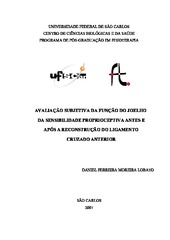| dc.contributor.author | Lobato, Daniel Ferreira Moreira | |
| dc.date.accessioned | 2016-06-02T20:19:05Z | |
| dc.date.available | 2007-08-16 | |
| dc.date.available | 2016-06-02T20:19:05Z | |
| dc.date.issued | 2007-02-26 | |
| dc.identifier.citation | LOBATO, Daniel Ferreira Moreira. Avaliação subjetiva da função do joelho da sensibilidade proprioceptiva antes e após a reconstrução do ligamento cruzado anterior.. 2007. 115 f. Dissertação (Mestrado em Ciências Biológicas) - Universidade Federal de São Carlos, São Carlos, 2007. | por |
| dc.identifier.uri | https://repositorio.ufscar.br/handle/ufscar/5205 | |
| dc.description.abstract | Several studies have shown the important role of the anterior cruciate ligament (ACL) in the
knee proprioception. However, there are still few studies that had evaluate the characteristics
of proprioception acuity in the early period of rehabilitation after the ACL-reconstructed
surgery, over all when it was associated to functional outcomes. Thus, the objective of this
study was to evaluate knee proprioception and subjective knee function in subjects who had
an ACL injury, before and after (3 months) the reconstruction surgery with the middle third
of patellar tendon autograft; and in control subjects. Ten volunteers who had unilateral ACL
injury (26.9±6.8 years) reconstructed group - and fifteen health volunteers (22.1±3.0 years)
control group performed a proprioceptive evaluation (joint position sense - JPS during
active and passive movements, threshold for detection of passive movement TDPM) on a
Biodex Multi-Joint System III Pro isokinetic dynamometer, at 2º/s and at two target-angles
(30º and 60º of knee flexion). The variables analyzed were the mean of angular displacement
(TDPM) and the mean of absolute error (JPS) in relation to each target-angle. The subjective
knee function was evaluated by Lysholm scale. The analyses of variance showed subjective
functional deficit in involved limb, compared to the uninvolved limb, as well as in relation to
the control group, in both test moments (p<0.01). Although no significant, the results showed
a tendency for higher TDPM in the reconstructed group (p=0.06). There was no significant
difference in the mean of absolute error between the groups (p>0.05), for any modality of
JPS, target-angles or test moments. The TDPM showed strong correlation with the subjective
knee functional score (just in the involved limb). Under the experimental conditions utilized,
the subjects who had an anterior cruciate ligament injury didn t show proprioceptive deficits
in relation to the control group, although of the subjective functional limitations presented. | eng |
| dc.description.sponsorship | Financiadora de Estudos e Projetos | |
| dc.format | application/pdf | por |
| dc.language | por | por |
| dc.publisher | Universidade Federal de São Carlos | por |
| dc.rights | Acesso Aberto | por |
| dc.subject | Fisioterapia | por |
| dc.subject | Sistema musculosquelético | por |
| dc.subject | Ligamento cruzado anterior | por |
| dc.subject | Propriocepção | por |
| dc.subject | Medidas de desempenho funcional | por |
| dc.subject | Avaliação isocinética | por |
| dc.subject | Anterior cruciate ligament | eng |
| dc.subject | Proprioception | eng |
| dc.subject | Functional outcome measures | eng |
| dc.subject | Isokinetics | eng |
| dc.title | Avaliação subjetiva da função do joelho da sensibilidade proprioceptiva antes e após a reconstrução do ligamento cruzado anterior | por |
| dc.type | Dissertação | por |
| dc.contributor.advisor1 | Serrão, Fábio Viadanna | |
| dc.contributor.advisor1Lattes | http://genos.cnpq.br:12010/dwlattes/owa/prc_imp_cv_int?f_cod=K4794266Y0 | por |
| dc.description.resumo | Diversos estudos têm evidenciado o importante papel do ligamento cruzado anterior (LCA)
na propriocepção do joelho. No entanto, ainda há poucos estudos que tenham investigado as
características da acuidade proprioceptiva no período inicial de reabilitação após a
reconstrução cirúrgica do LCA, sobretudo quando associada a aspectos funcionais. Diante do
exposto, foi objetivo do presente estudo avaliar a sensibilidade proprioceptiva e a função
subjetiva do joelho em indivíduos com lesão do LCA, antes e após (3 meses) a reconstrução
cirúrgica pelo terço médio do tendão patelar autógeno; e em indivíduos controle. Dez
voluntários com lesão unilateral do LCA (26,9±6,8 anos) grupo reconstruído - e quinze
clinicamente sadios (22,1±3,0 anos) - grupo controle - realizaram uma avaliação
proprioceptiva (percepção da posição articular PPA - durante os movimentos ativo e
passivo, limiar de detecção do movimento passivo LDMP) no dinamômetro isocinético
Biodex Multi-Joint System III Pro, a 2º/s e em dois ângulos-alvo (30º e 60º de flexão do
joelho). As variáveis estudadas foram o deslocamento angular médio (LDMP) e o erro
absoluto (PPA) em relação a cada ângulo-alvo. A função subjetiva do joelho foi avaliada por
meio da Escala de Lysholm. A análise de variância indicou déficit funcional subjetivo no
membro envolvido, comparado ao membro contralateral, bem como em relação ao grupo
controle, nos dois períodos de teste (p<0,01). Embora não significativo, os resultados
indicaram tendência de maior LDMP para o grupo reconstruído (p=0,06). Não houve
diferença significativa entre os grupos quanto à média de erro absoluto (p>0,05), para
qualquer uma das modalidades de PPA, ângulos-alvo ou períodos considerados. O LDMP
apresentou forte correlação com o escore funcional do joelho (apenas para o membro
envolvido). Nas condições experimentais utilizadas, os indivíduos com lesão do LCA não
apresentaram déficits proprioceptivos significativos em relação ao grupo controle, apesar das
limitações funcionais verificadas subjetivamente. | por |
| dc.publisher.country | BR | por |
| dc.publisher.initials | UFSCar | por |
| dc.publisher.program | Programa de Pós-Graduação em Fisioterapia - PPGFt | por |
| dc.subject.cnpq | CIENCIAS DA SAUDE::FISIOTERAPIA E TERAPIA OCUPACIONAL | por |
| dc.contributor.authorlattes | http://lattes.cnpq.br/3736858758375395 | por |
